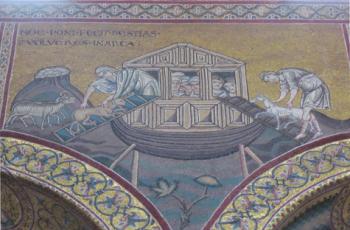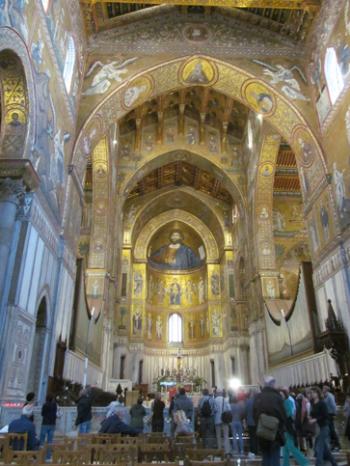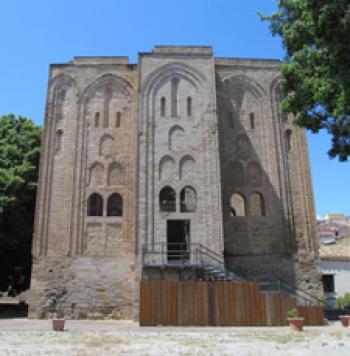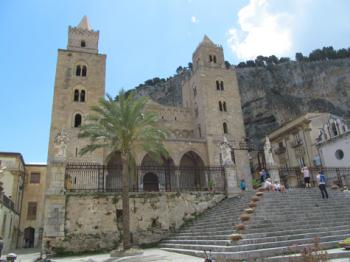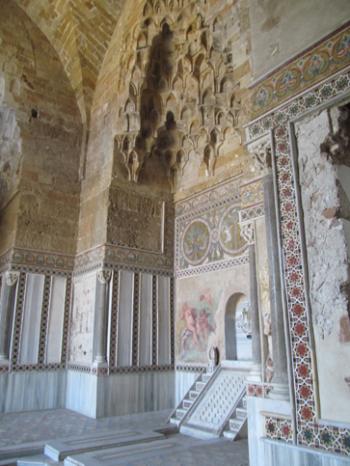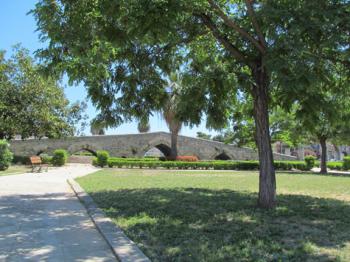Norman Palermo (Part 2 of 2)
This item appears on page 56 of the February 2017 issue.
(Second of two parts)
By the time I had finished visiting the five (arguably) major Norman sites in Palermo, Sicily (Italy), described in my January 2017 column, I was hooked on the Normans and all that still remained of their era even after more than 800 years. I wanted more.
Pleasure palaces
In addition to building churches, chapels and palaces, the Normans built intimate pleasure palaces for themselves, probably to escape the intense summer heat of the city. One such palace (perhaps “palace” is too grand a word, since this place resembles a small fort more than a palace) was La Zisa.
In its time, La Zisa was in the countryside — not far from the main palace but far enough away so that the court could make a visit a day’s outing or even an overnight stay.
La Zisa was built in the mid- to late-12th century by William I and William II, son and grandson of Roger II, the first of the Norman kings to rule Sicily.
It is probable that Moorish craftsmen were employed in its construction. Witness the open-sided room with a mosaic frieze, a fountain and the same muqarnas (honeycomb Islamic decorations) found in the Palatine Chapel within the Norman Palace. La Zisa is now only a shell, although it houses a small collection of Islamic pottery, ceramics and lattice screens.
The same royal park that once surrounded La Zisa also included La Cuba, built around 1180 by William II. It is one of the last Norman monuments built in Palermo before the arrival of Henry VI, the Swabian successor to the throne (through marriage to Constance, Roger II’s daughter).
Like La Zisa, La Cuba is small. It is built around an open central courtyard with a star-shaped pool. La Cuba, too, served as a respite for the royals from the summer heat as well as a hunting lodge.
Lesser-known masterpieces
In Kalsa, one of the oldest sections of Palermo, stands La Magione, a church built in the late 12th century by Matteo d’Ajello, chancellor to William II. A large garden leads up to the church through an archway. There is a small cloister adjacent to the church. The best place to appreciate La Magione’s Norman profile is to view its east end from the park behind the church.
Very few travel books mention these next two early Norman sites, which are infrequently visited. San Giovanni dei Lebbrosi (St. John of the Lepers), probably the oldest Norman church in Sicily, was built in the 11th century. Like most Norman churches before they were altered or expanded later on, as were the Duomo and La Martorana, San Giovanni is simple yet elegant.
Nearby is the Ponte dell’Ammiraglio (Bridge of the Admiral), built by the same George of Antioch, admiral under Roger II, who built La Martorana. The Oreto River that the bridge once spanned was diverted long ago, so the bridge now seems out of place and isolated, but it is still lovely to see, nonetheless.
Monreale mosaics
There are two other sites that should be added to any not-to-miss list of great Norman places.
At the top of the list, up there with the Palatine Chapel, is Monreale Cathedral. It’s located only nine miles south of Palermo and is easily reached by taxi in about 20 minutes. The small hill town of Monreale is dominated by this cathedral, begun by William II in 1174 together with a palace that was later converted into the archbishop’s residence.
From the late Norman period are the east apses, the west towers, the western bronze door by Bonanno Pisano (who was also one of the architects of the Tower of Pisa), the cloisters with intricately carved capitals — including one of William II offering Monreale Cathedral to the Virgin — and, above all, the fabulous mosaics inside the cathedral.
Characters from the Old Testament come alive in these mosaics: a weary God the Father sits resting after creating the world; an angel pushes Adam and Eve out of paradise, and Noah’s ark rests on a pair of humpbacked hills after the Great Flood. There are vivid scenes from the New Testament as well. Over it all looms the powerful mosaic of Christ Pantokrator in the central apse.
As with the Palatine Chapel, you need three things: plenty of time to appreciate the mosaics, binoculars (nice to have but not absolutely essential) and a good guidebook. The shop outside the north entrance to the cathedral has several good books for sale; we chose “Monreale,” published by Casa Editrice Mistretta.
Cefalù mosaics
Located 48 miles east of Palermo, Cefalù is a beautiful town with its back against a steep rocky outcrop and its face toward the Mediterranean. It is so beautiful that I regretted not spending at least an overnight.
Besides the town and the delight of strolling its narrow streets, there is the Duomo, or Cathedral, the main reason for our half-day excursion from Palermo.
The Cathedral was begun by Roger II in about 1131. Like the Palatine Chapel in Palermo and Monreale Cathedral, it’s the mosaics one goes primarily to see, especially that of the Christ Pantokrator in the apse. It is supposedly the oldest in Sicily. Below Christ are arrayed angels, apostles and the Virgin. The mosaics on the choir walls date from a century later, after the Normans no longer ruled Sicily.
There’s a lovely cloister adjacent to the north side of the Cathedral with capitals that should not be missed. On the outcrop called La Rocca that looms above the Cathedral, there are the ruins of a Greek temple and of a medieval castle. It’s a steep climb that we decided not to do, opting instead for cappuccinos and cannoli at one of the cafés at the foot of the stairs leading up to the Cathedral. According to the café waiter, the columns from the Greek temple are now part of the nave of the Cathedral.
Cefalù is a one-hour ride from Palermo, a trip we did with a private car and driver. The few hours we had were not nearly enough time to see the Cathedral and cloisters and to take a stroll through town. Allow at least a full day or, better, an overnight.
Sicily as a crossroads did not end with the Norman era. After the brief period of Norman dominance came the Swabians, Angevins, Aragonese, Spanish, Piedmontese, Austrians, Bourbons, British and… Giuseppe Garibaldi, the catalyst for the unification of Italy. They all left something of themselves behind.
More to see
To all the Norman treasures we visited in Palermo, I would add an additional “must see” list: the intersection called I Quattro Canti, where four elaborately decorated 17th-century palazzi facades stand at each corner like four stately dowagers; the beautiful Piazza Pretoria and Piazza Bologni, each only a few minutes’ walk from I Quattro Canti; the three oratories of San Lorenzo, San Domenico and Santa Cita, each a rococo masterpiece of the sculptor Giacomo Serpotta; the Punic-era necropolis next door to La Cuba; the lively food markets of the old section, especially Ballarò, and the delightful marionette theaters that offer performances on a regular basis.
We went to two of the marionette theaters: Teatro Argento at Via Pietro Novelli 1, across from the Duomo, and Figli d’Arte Cuticchio at Via Bara all’Olivella 95, near Teatro Massimo.
Too many visitors to Palermo rush through trying to see it all in a few days. It’s a mistake. Palermo is a city to savor, preferably mixing small doses of sightseeing with plenty of time to linger in cafés over cappuccinos or a carafe of Sicilian wine.
One of our favorite places to linger was Carlo V’s (No. 22 Piazza Bologni; phone +39 091 328856), especially toward sunset. Carlo’s became our outdoor living/dining room, as, during our 5-week Palermo stay, we returned more than a dozen times for late lunch, an evening aperitif or dinner.
Lunch or dinner there cost an average of €54 (near $57.50) for shared appetizer, two entrées, two glasses of Sicilian wine and two espressos.

